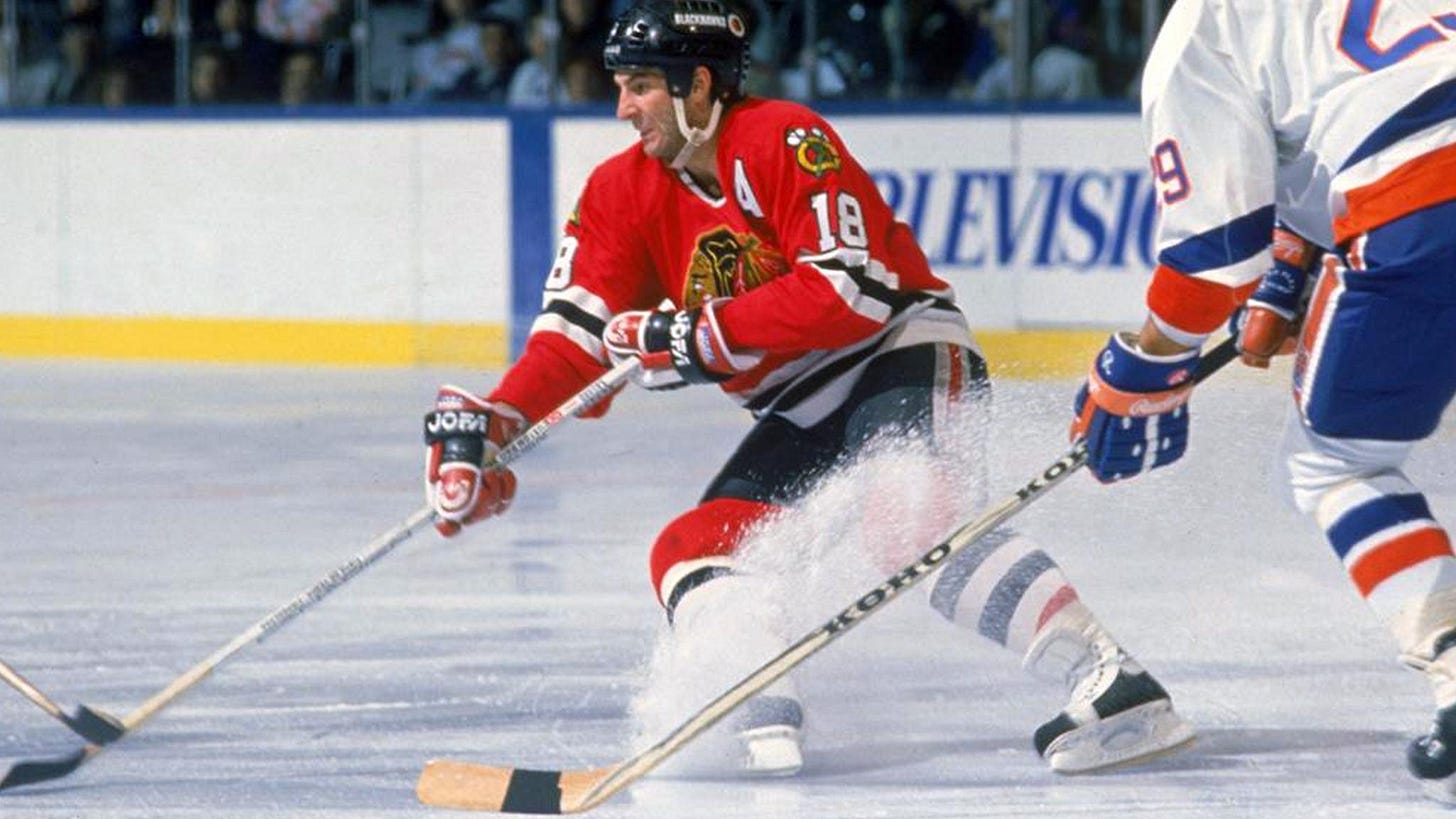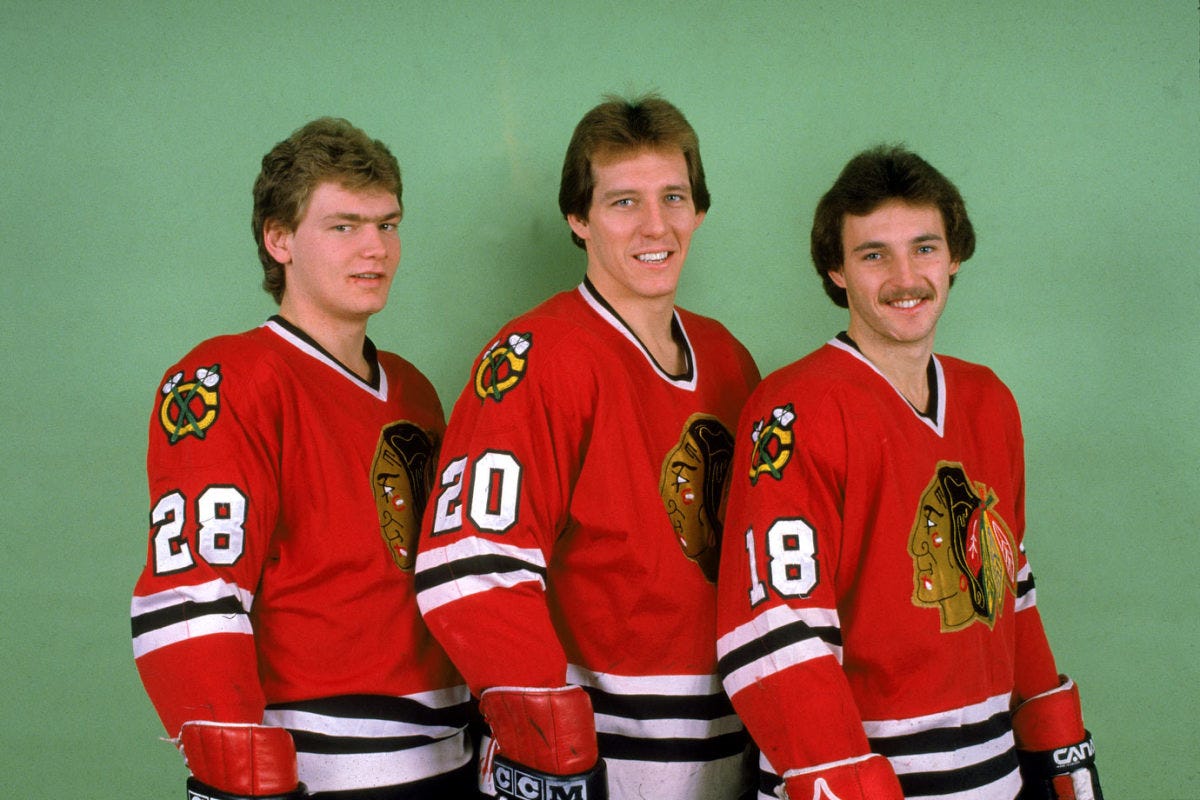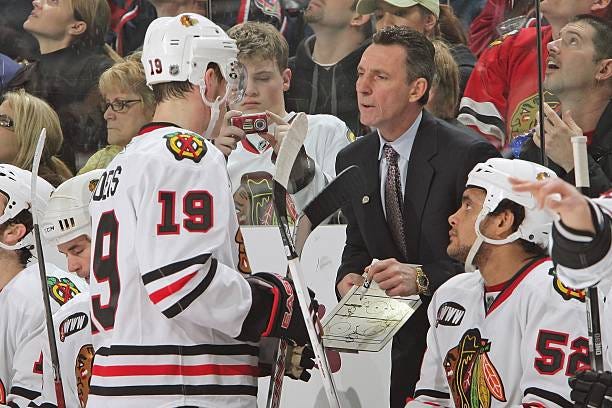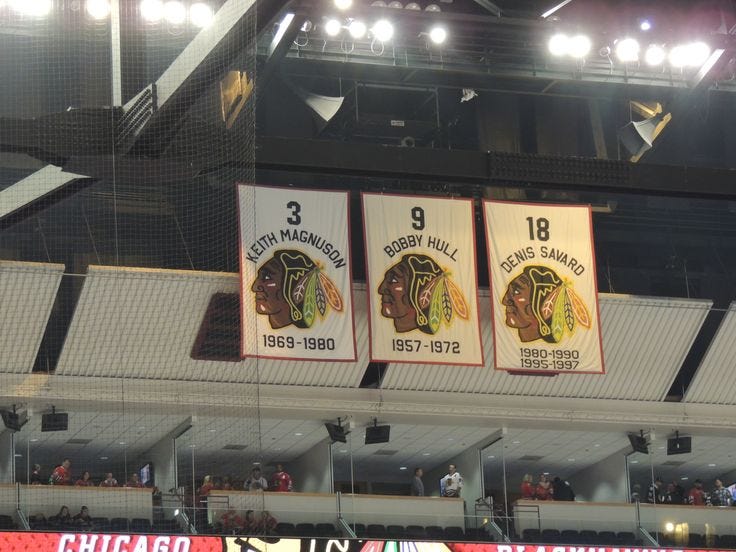Hawks History: Savard
A look at Savard's career as a Blackhawk

It’s Tuesday December 30, 1986. You just got home after working. The commute was long. Your car’s heater protected you from the Chicago winter. A cool 35 degrees.
Now you’re rushing to shed off your winter layers. Pat Foley’s muffled radio voice echoes in your mind. The Hawks are tied with Detorit 3-3. It’s the third period.
Your boots now sit in a puddle of melting slush. You’ll clean it up after the game.
You rush to the couch and flip on the boob tube, its warm static glow casting a blue-gray light on the wood panel walls.
White noise blares from the TV as you search for the Hawks. Chunk. Chunk. Chunk.
Then you remember. The Black Hawks are playing in the Stadium. The game isn’t on TV.
You flip the tube off and rush to your radio. It’s already set to WBBM.
“Denis Savard gets it to Larmer… Wings standing around… Larmer good move… here’s the shot he scores!”
All is well in the world. Hawks up 4-3.
New Dreams
Born in Gatineau, Quebec on February 4, 1961, the French-Canadian young phenom was all but expected to go to the Montreal Canadiens during the 1980 draft. The Canadiens held the first-overall pick, it only made sense for Savard to be drafted by Les Hockey Club de Canadiens.
To the fans’ dismay, the Canadiens would draft Doug Wickenheiser and Savard would fall in the Chicago Black Hawks laps at pick number 3. This made Savard the highest-drafted player in Black Hawks history until 2007. Two other notable names were drafted by GM Bob Pulford, Troy Murray and Steve Larmer at pick 120.
Savard would debut right away for a spectacular rookie season.
October 9, 1980. It’s the season opener for the Hawks and the Sabres are in town.
Savard’s first NHL game would kick off his memorable career with a bang. Savard notched 3 assists to help the Black Hawks beat the Sabres 4-3. Denis assisted on goals from John Marks, Darryl Sutter, and Rich Preston.
A couple days later, the Hawks were gearing up for game 2 of the 1980 season. Their foe, the Canadiens. Not only would the Hawks go on to beat them 5-4, but Savard would score his first goal and assist on another. Salt in the wound for Canadiens fans.
By the end of the season, Savard put up 75 points (28 goals, 47 assists) in 76 games. A near point-per-game pace. The most points by a rookie in Hawks history until Steve Larmer broke that record in 1983.
Savard seemed all of that and more, old time Hawk fans had flashbacks to Bobby Hull. The Black Hawks finished the 1980 season and headed off into the playoffs. Despite opening the season with two impressive wins, the Hawks went 12-22-6 during their first 40 games. They would come around and finish with a 31-33-16 record. Good enough for second place in the Smythe Division. The Calgary Flames would sweep the Hawks in the first round.
TV Party
The 1981 season saw head coach and beloved Black Hawk Keith Magnuson resign during a bad stretch. Bob Pulford took the reigns. The Hawks ended up grabbing the last playoff position in the Norris Division. They would make it to the Campbell Conference Final and lose to the Canucks.
That season was also an impressive sophomore season for Savard. He finished with 119 points, the most points by any Hawk up to that time. Teammate Al Secord led the team with 44 points during his second season with the Hawks. Secord was acquired in a trade with Boston the season prior. Both Secord and Savard provided the offensive punch needed during this high-scoring time in NHL history. There was just one piece missing.
The 1982 season generated excitement for Hawks fans as rookie Steve Larmer cemented himself as a full-time player. Larmer joined Savard and Secord on a line that would terrorize the ice. “The Party Line” would go on to generate an impressive 197 points that season. Secord with 86 points, Larmer with 90 (earning him the Calder), and Savard with a whopping 121 points.
With Savard centering the Party Line, Chicago would finish with 104 points, leading the Norris Division and finishing in 4th place overall. Despite their regular season success, the Hawks would get swept in the Conference Final against the Oilers.
The Party Line was special. Speed and talent in all three players while Secord and Larmer both brought grit and toughness. The 1983 Conference Final would summarize the Hawks of the 80s. Despite having a legendary line, the Hawks would fail to beat teams like the Oilers. Greatness was close but out of reach.
You Spin Me Round
The rest of the decade would see the Hawks consistently make playoff appearances. The Hawks would either make it to the Conference Final to get beat by the Oilers or they would struggle to win the first round.
Despite being a playoff team, the Hawks only had three winning seasons. With offensive power in the Party Line and players like Troy Murray, the Hawks could score goals. Preventing goals was a different story.
After the ‘83 season, Tony Esposito would retire from hockey. This began the revolving door in net for the Hawks. Consistency in goal-tending would become a thorn in the Hawks side.
Consistency wasn’t an issue for Savard, however. From 1983-1990, Savard put up three 100+ point seasons. This included the 1987 season where he put up 131 ooints (44 goals, 87 assists), a Blackhawk record that still stands today. To put that in context for that high-scoring era, Savard would rank 3rd overall in the NHL with points. Wayne Gretzky was at second with 149 points and Mario Lemieux held the 1st spot with 168 points.
Savard had engraved himself in Blackhawk history. Fans loved him among a cast of memorable Hawks players. Denis dazzled fans with his offensive skill on ice, his ability to create plays, and his signature “Savardian Spin-O-Rama” goal (named after, ironically enough, Serge Savard and not Denis).
By the end of the decade, the Hawks were still on the outside looking in for the Stanley Cup. Savard’s scoring had slowed down and at age 29, he was just past his prime. With the Hawks landing a solid power-forward by the name of Jeremey Roenick, New GM and coach Mike Keenan decided to take a risk on young JR. He saw Roenick as someone who could potentially fill Savard’s shoes.
In the 1990 offseason, Denis Savard was traded to the Montreal Canadiens in return for defenseman and Chicago-native Chris Chelios and a 2nd Round Pick.
Don’t Cry
While the Hawks clawed as close as they could to Lord Stanely, Savard would have his name engraved on the Cup in 1993 with the Canadiens. Savard’s career was now in its twilight. He had acted as an assistant coach during the ‘93 postseason due to a hairline fracture in his ankle. Denis would sign with the Tampa Bay Lightning in the ‘93 offseason where he played for a season and a half.
April 1995 would see the return of Savard to Chicago. Denis came back to a Chicago team that had only come close to winning one Stanley Cup. And, though no one knew it, the team was on the verge of big change.
Savard’s last two NHL seasons weren’t as dazzling as his start. At 34, Savard played 69 games in the ‘95 season and 64 in the ‘96 season, scoring 48 and 29 points respectively. It was during his last season that the Hawks of the ‘90s went through change. Roenick would be traded in the 1996 offseason and Ed Belfour would play his final season in Chicago.
Although Captain Chris Chelios, forward Tony Amonte, and young talent Eric Daze remained with the Hawks, dark times reared its ugly head in the newly constructed United Center. Savard would still be there, however. In December 1997, he was named Assistant Coach.
In 1998, number 18 was retired by the Blackhawks and forever hangs in the United Center in reverence to Savard. In the year 2000, Denis was inducted into the Hockey Hall of Fame.
For the Hawks, so began the dark times. The Blackhawks withered into irrelevance heading into the 21st century. Losing kept the United Center empty most nights. For Savard, he continued to coach as an assistant until 2006.
Coach Trent Yawney was fired and Savard was named head coach. On his roster, he had Martin Havlat, Tuomo Ruutu, a young forward named Patrick Sharp, and two young defensemen in Duncan Keith and Brent Seabrook.
The players loved him.
Next year, Jonathan Toews was slated to make his debut. The future had a glimmer of hope, but that all changed when Chicago won the draft lottery. GM Dale Tallon used the number 1 pick to select Patrick Kane.
2007 would see Toews and Kane debut. The Hawks won more than 40 games for the first time in six years and just missed the playoffs by 3 points. Savard would also give a speech in which he demanded more from the Hawks after a loss. They needed to “commit to the indian.”
The 2008 season wouldn’t last long for Savard. Four games into the season and a 1-2-1 record, he was fired and replaced by a scout who was hired the previous summer. While fans weren’t too shocked that Joel Quenneville took the reins (there was no way he was hired to only be a scout), Savard and the players took it hard.
Denis would remain with the Blackhawks as an ambassador. He would be there when the Hawks won 3 more cups.
A legacy going back to 1980, Savard left his mark on Chicago forever. From his days on the Party Line in the 80s, to his homecoming in the 90s, and there’s no doubt Savard made a culural impact on the players as a coach.
One of the greatest Blackhawks of all time.
Let's Go Hawks.
Sources:
Chicago Blackhawks (1995), by Ross Rennie
Hockey Chicago Style: the history of the Chicago Blackhawks (1990), by Paul R. Greenland
The Chicago Tribune Book of the Chicago Blackhawks: A decade-by-decade history (2017), Chicago Tribune Staff
”Remember when… the Blackhawks hired Denis Savard to coach,” August 26, 2023 by Nate Brown, Chi Hockey Now







